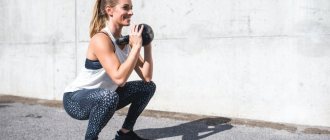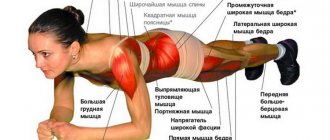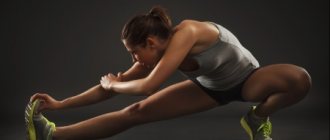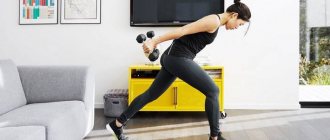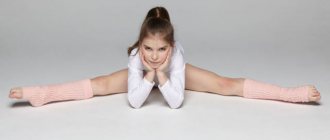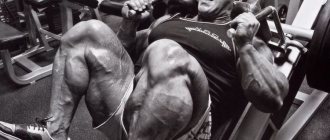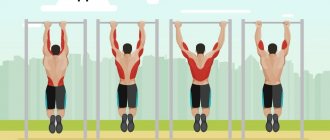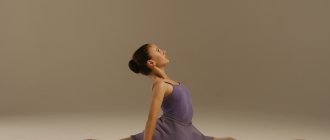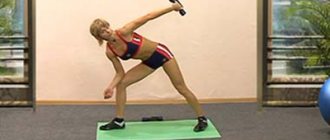December 5, 2012
These exercises help you move more easily and avoid pain when performing daily household chores.
Stretching exercises allow an older person to move more easily and avoid pain when performing daily household chores. However, we must remember that exercises alone to increase joint mobility and muscle elasticity do not make a person more resilient and stronger. They need to be performed in combination with strength exercises and cardio training.
Safety regulations
- Always warm up
before stretching exercises: take a few dozen quick steps in place, raise your arms and bend your torso to the sides. It's even better to stretch after endurance exercise or strength training. - Mild muscle and joint discomfort after stretching is normal, but exercise should never cause pain
. - Never make sudden movements
when stretching - move gently, smoothly and do not stretch more than your body allows. - Stretching at least three to five times a week
.
Stretching exercises at home
These exercises can be performed as a warm-up before starting strength training, or as a full-fledged lesson. No special equipment is required to perform them, so everything can be easily done at home or outdoors.
Knee to chest
Stand straight, confidently resting on both feet. Bend your right leg at the knee and pull it towards your chest.
Ideally, the knee should be pressed tightly against the body, but this does not need to be achieved if the exercise is being performed for the first time. Find your maximum possible and stay in this pose, helping yourself with your hands.
"Frog"
Sitting on the floor, pull your legs towards you as much as possible, placing your feet on the floor. Slowly begin to spread your knees out to the sides, aiming to place them on the floor.
You can help yourself with your hands, lightly pressing your elbows on your knees. Don't press too hard, there shouldn't be any pain.
"Frog Lying"
Lie on your back and, bending your knees, begin to spread them in different directions, trying to place your thigh on the floor.
You can help yourself with your hands, but no sudden movements.
Lunges
Take a big step forward with your right foot. The bent knee of the front leg should form an angle of 90 degrees.
The left leg should be straight. During the exercise, you can put your hands on your belt; if it becomes difficult, you can lower them to the floor.
"Ring"
Lunge forward with your right leg as in the previous exercise. Then, bending your left leg, gradually sit down on it, fully straightening your right leg.
When performing the exercise, pull the toe of your right foot towards you to better feel your calves.
"Pigeon"
Sit on the floor, bend your right leg in front of you at the knee. Gently move your left one back and try to press your thigh to the floor.
You should feel the upper thigh well.
Cross twine
Sit on the floor with your straight legs spread as wide as possible. Bend your body forward, aiming your chest towards the floor.
Make sure your back remains straight and your toes point up.
"Child's Pose"
Sit on your heels, spread your legs slightly, pointing your knees in different directions. Lean forward with your body on your knees.
Stretch your arms forward on the floor as far as possible. You should feel the muscles of your back and arms.
Thigh muscle stretch
Attention! If you have had hip replacement surgery, do not do this exercise!
1. Lie on the floor on your back. 2. Bend your knees and place your feet on the floor. 3. Bend both legs with bent knees to the side as low as you can. 4. Hold your legs in this position for about ten seconds. 5. Return to the starting position. 6. Repeat the exercise three to five times in each direction. Photo: RON SOMBILON MEDIA, ART and PHOTOGRAPHY
Tags:
- Older age
- Stretching
- Exercises
To leave a comment you must be an authorized user
Exercises to create a flexible body
Some physical exercises to stretch the muscles will help keep your body in good shape. Athletes in the field of gymnastics and swimming also adhere to this. Many sports programs are designed to develop joint elasticity. For example, yoga, aerobics and some dance styles.
Stretching is the way to a youthful body
There are basic exercises that you can do at home. It is important not to be lazy and do them daily. Then, as a result, you will get an even posture, a refined figure and a graceful gait. In addition to beauty, a flexible body can easily endure physical activity.
What exercises should I start doing?
Here are some tips to help you get started on your journey to body flexibility:
- exercise often and regularly;
- Before the main lesson, be sure to warm up;
- First, choose a set of simple exercises for yourself;
- keep a calm pace, 10 approaches lasting no more than 20 seconds;
- do not tolerate pain.
Example of some exercises
- Stand straight, place your feet wide. Stretch forward, wrap your arms around your legs from behind, keeping your back straight. Stay in this state for about 20 seconds and then return to the starting position. This exercise will improve your spinal
health . - Stand straight and place your feet approximately shoulder-width apart. Grab your knees with your hands and rotate first away from you, then toward you. This will allow the knee joints to develop well and will be beneficial for long-standing injuries.
- Sit on a chair with your back straight and shoulders back. Keeping your lower body stationary, rotate your upper body 180 degrees, trying to touch the back of the chair. Breathe evenly. As you inhale, try to rotate to the maximum level. Sit up straight and repeat this exercise, only in the opposite direction. In the process, you will stretch the side muscles of your body.
- Sit on the mat with your legs extended forward, your back and neck should be straight. Lift your right leg up, clasp your shin with the opposite hand and your thigh with the other. Stretch until you feel strong tension. It is important to always keep your back straight. Exercise improves the condition of the thigh muscles.
- Stand up straight, place your right hand behind your back, take your left hand behind your shoulder, point your elbow joint up. Now try using both hands. Keep your spine straight. Change the position of your hands and perform a repetition with your left hand behind your back and your right hand behind your shoulder. If you don’t succeed the first time, don’t worry, after a few trainings everything will definitely work out.
- Sit with a straight spine. Join your two hands into a “lock”, placing them on the top of your head. Begin to press lightly on the back of your head, while slowly tilting your head down. Then raise your head up. Make several attempts and then rotate your head 10 times in different directions. After such exercises, the neck will become flexible, blood flow to the head will increase, which will minimize headaches.
Once you have mastered the basic workout, you can add new exercises that you think will benefit your body the most. But try not to overexert yourself.
How to achieve effectiveness from training?
A person of any weight and regardless of age can begin to engage in muscle stretching. However, everyone determines the amount of load and suitable exercises individually. If you are a beginner athlete, it is better to seek help from experienced coaches and professional athletes.
In any sports center they will not refuse you help and will select a personal training program. They will also provide advice on all important issues - from advice on exercise technique to creating a personal diet and exercise regimen. Sprains
become less likely when you start training with professionals
. Author: K.M.N., Academician of the Russian Academy of Medical Sciences M.A. Bobyr
Straight leg raises while lying alternately
Alternating Lying Straight Leg Raises
This is a dynamic muscle stretch that helps stretch the hamstrings, the muscles that form the back of the thighs. Lie down on the mat. Hands along the body. Alternately raise your straight legs to a vertical position. Feel the stretch in the area behind your knees and in your hamstrings. Repeat the exercise at least 10-15 times for each leg.
Formation of flexibility in physical education lessons
Using special techniques, teachers in physical education lessons develop body flexibility in their students.
You can do this in several ways:
- through exercises performed to maximum amplitude (in this case, the goal is to increase the elasticity of antagonist muscles, which are limiters when the student’s body moves);
- through exercises with your own body weight (for example, in the “frog” position, the child should make smooth pressing movements on the knees using the weight of the upper body). This format of physical activity is the most effective and safe;
- through exercises with sports equipment (stretching in physical education can also be done using a hoop, balls of varying hardness, and an expander);
- static pair exercises (teachers practice this type of stretching only with high school students who can qualitatively control the force on their partner’s muscles).
What is flexibility
This is a person’s ability to achieve a large amplitude in the movement performed. In practice, the term is most often used when discussing joint mobility. However, mobility and flexibility are not interchangeable concepts. Flexibility still characterizes the general condition of a person, and not the characteristics of individual joints.
For beautiful posture, smooth movement and ease of gait, the development of flexibility is necessary, because in its absence there is no point in talking about some kind of grace. Beauty and flexibility are practically synonymous. Imagine a beautiful, slender girl with good height and a harmonious figure. You can admire such a spectacle, but on the condition that there is no sharpness, roughness, or some intermittency in her movements. If she walks with her back thrown out like a wheel and her head buried in her shoulders, then her beauty is somehow quickly lost, and defects in posture come to the fore.
Flexibility is the total mobility of the joints of the entire body. What does this characteristic of our body give in practice? From simple life situations - if you have flexibility, you will not grunt when you bend down to pick up a fallen handkerchief. You can easily reach the salad on the far edge of the table. You can dance tango and rumba. Ultimately, when you fall, you will be able to coordinate and protect the most fragile parts of your body from damage.
Good flexibility provides freedom, speed and ease of movement. With it you can put in the least effort when performing physical exercises, but get the most effective results. But for an ideal result, the development of the entire organism is required, otherwise the lack of flexibility of individual parts of the body makes it difficult to coordinate the movements of the entire organism.
For dancers, physical flexibility is the key to success, since movements must be performed with a large and extreme amplitude. For example, if there is a lack of flexibility, a muscle cramps - this can cost you a lost prize at a major competition. Therefore, dancer-athletes do not spare themselves during training, understanding that the entire body must work like clockwork in order to complete the intended task. General physical fitness training is performed exclusively after a serious “warm-up” of the muscles, and at the end of the session there is a mandatory “cool-down” with stretching. A different order can lead to muscle and ligament injuries.
Complete stretching complexes
Naturally, you can stretch as a form of exercise before performing basic exercises, or you can seriously take on the flexibility of your own back and put your spine in order. This is especially necessary for those who, for some reason, have minor spinal defects (scoliosis is no worse than the first degree) and want to straighten their back through the formation of a stable muscle connection and begin more serious loads.
In addition, stretching can be done on non-training days to improve movement control.
| Name of the complex | When to do it | Exercises |
| Base | Training day, warm-up |
|
| With a sedentary lifestyle | Non-training day | Hanging on the horizontal bar – 3-5 approaches for maximum time |
| Female 1 | Training day, warm-up |
|
| Female 2 | Non-training day or after training |
|
| Specialized stretching | Non-training day | Warm-up + non-training day (women's 2) 2-3 laps |
Sets of exercises for students
Sets of exercises for students of different classes vary in intensity. This is due to the age-related developmental characteristics of children.
An example of a set of flexibility exercises for schoolchildren
The most effective stretching complexes are:
| Age of schoolchildren | Optimal sequence of exercises |
| 1st – 5th grades |
|
| 6-9 grades |
|
| 10-11 grades |
|
Exercises for schoolchildren aimed at developing flexibility, in the vast majority of cases, are universal and have no contraindications for their implementation.
Regardless of the age of the children, their stretching should be carried out under the guidance of an experienced teacher who can not only explain the technique of performing the exercises, but also monitor the process itself in order to protect young athletes from injury.
